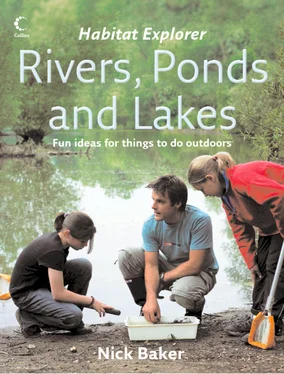Water fleas, or daphnia, are not fleas at all; they just twitch and jump about like them. They are one of the most common of the freshwater crustaceans.
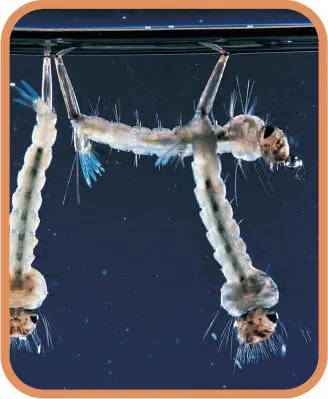
Mosquito larvae are very quick to colonize tiny little puddles and pools of trapped water. The contents of water butts, old car tyres, even jam jars, soon start to twitch with the eggs, larvae and pupae of this infamous insect.
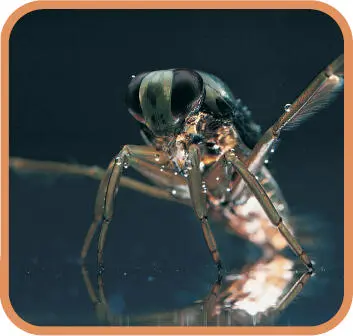
Water boatmen, like many adult water insects, actually have wings folded away and are excellent aeronauts. This means they are some of the first colonizers of a new pond, magically appearing, seemingly out of nowhere.
Aeronauts and aquanauts
Now you can understand how tiny little thingslike water fleas can turn up in a puddle, but what about larger pond life, such as beetles, water boatmen and pond skaters? If you look in a newly dug pond or a cattle trough, you are more than likely to see a multi-eyed, six-legged water bug go rowing past. How did it get there? Well, wonder no more; the answer is that it arrived by air. To prove this, follow the steps opposite.
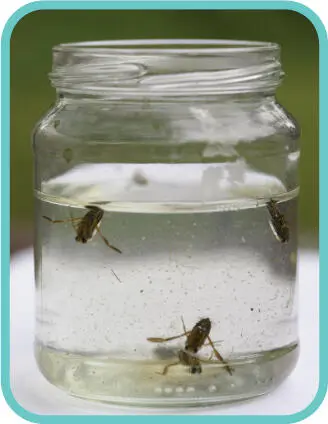
Some aptly named water boatmen – their back legs look like oars and bodies like hulls.
Fab facts
* These insects are thought to be very sensitive to the kind of light that is reflected off the surface of water, such as ponds, lakes and streams. So when they go buzzing about above us in the air, how do they find their new home? It turns out they are able to see the light as it is reflected from the water’s surface.
* The sad thing is that this worked perfectly well before mankind came along and confused things! Car bonnets and roofs look similar to water as they reflect the same kind of light and many pond insects, including water boatmen and water beetles, try to touch down in our car parks and on our roads – both fairly unfriendly places to end up dazed and spinning on your back!
1 A big water boatman is an ideal insect to catch. It is big, so you can observe it a lot easier, and it is also easy to identify as an adult. Water boatmen are the ones with the silvery white backs, which is easy to see when they are flipping around in your net.
2 Gently remove the insect from the net. Try to lift it without squeezing, as it can deliver a painful bite with its stabbing mouth parts. Hold it in the flat palm of your hand. It may leap about a bit at first, but it isn’t in pain, or suffocating – trust me!
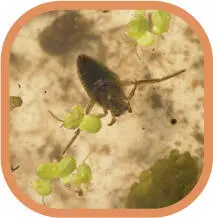
3 It will soon settle down with it’s back facing up, so watch it carefully. The next bit usually happens in a couple of minutes, depending on how sunny or hot it is. Watch for it to open the top of its back and start pumping its abdomen back and forth. Any second now, the boatman will unfold its wings and buzz off to find a new pond. The mystery is solved – most adult bugs have leathery wings and are good fliers. This is handy as they can check out new homes, or simply make the most of temporary ones!

Take it further
* This is just a fun little experiment that helps us know how water boatmen, also known as backswimmers, orientate themselves in their underwater world.
* Take a small jar of water with your boatman in it to a dark room. Turn out the lights and shine a torch in the jar from underneath. What happens? Your water boatman – and here you must remember its other common name – has become a front swimmer. This proves they use light direction to orientate themselves in the water and not gravity.
Handy stuff: an aquarium
Scooping some strange and alien life formsout of the water, looking at them for a few minutes in a tray and then putting them back can be just a little dissatisfying. Yes, if you are lucky, you may see gills twitch, a bit of scrabbling around and, if you are a good naturalist, you may be able to put a name to the creature. But surely there is more to their lives than just that? How fast do they grow? How do they eat? Do they change colour? What do they turn into?
With just a bit of knowledgeabout how to set up an aquarium properly you can take a little piece of the pond or stream and some chosen subjects back home with you. It is only by gazing into their wondrous little lives day in, day out that you really get to know them and study them properly.
Remember, however, that once any living creaturehas been lifted out of its home in your net, it is your responsibility. Be sure not to over-stock your tank and not to mix predators with prey as almost certain carnage will result. It’s all about balance. Try to resist having too many individuals of any one species. One or two snails are good, but if they get happy, they will breed and eat all your plants. Lots of predatory fish or beetles look good, but may kill other, more delicate, creatures.
Do your research about the food requirementof your captives and look after them. If they are not looking happy, then you are probably doing something wrong. If this is the case, release your inmates back where they came from and think about your set-up. Adjust the tank accordingly and try again with fresh specimens.
Here is the great pond snail – it’s looking great indeed.
YOU WILL NEED
> fish tank
> gravel
> weed
> pump (optional)
1 A water-tight tank with clear sides is the minimum requirement. I prefer glass ones as they do not scratch or discolour, but they can chip, crack or smash if you are not gentle, and plastic ones are so much cheaper, lighter and readily available.
2 The next consideration is the type of water environment you are trying to recreate. If you are studying pond creatures for just a few days, all you really have to do is fill the tank with water and a few weeds and watch.
3 But if you are keeping your creatures for any longer, some gentle filtration and water circulation is a good idea. This keeps the water from becoming stagnant, ups the oxygen levels and removes and prevents a build-up of harmful substances. All this can be provided by an in-tank filter pump, again relatively cheap and available in many sizes, depending on the size of the tank it needs to filter. For species that live in running water, you may need to have quite an aggressive water flow, but the principles are the same.
4 Use rain water or water from where you got your creatures. Tap water can be used, but as there is added chlorine, it needs to stand for a few days before putting in your catch. Ideally, set up your aquarium a week in advance of adding them.
Make a micro zoo

The thing about ponds and lakesis that they are busy with life. Because they are so chock-a-block, competition for resources, like space and food, is intense. Puddles, on the other hand, tend to dry up from time to time and so are relatively empty. Now, to any creature this represents a challenge: to get life in a puddle licked you must have a speedy life cycle. You must be able to adapt so you can handle the extreme and often rapid changes in temperatures as well as sometimes very salty conditions. Do this, and you have the place pretty much to yourself.
Читать дальше
